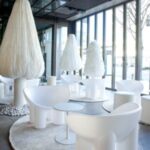
The MacBook Pro has returned in a new color. On October 31st (local time), Apple revealed the new MacBook Pro with M3, M3 Pro, and M3 Pro Max at the ‘Scary Fast’ event. Along with this, a new color option, ‘Space Black,’ was also introduced.
Space Black is darker than the existing Space Gray and leaves fewer fingerprints. How was this achieved? On November 10th (local time), the self-repair company iFixit analyzed the technique used in Space Black.
Difficult Process: Gray Screen

MacBooks use aluminum material and go through an ‘anodizing’ process. This is a process of forming an oxide film on the surface of aluminum through chemical treatment, which makes it durable and resistant to corrosion. Anodizing is also referred to as anodizing.
During the anodizing process, adding dye can create various colors. In the past, Apple wanted to make a Black MacBook using black dye.
However, getting the desired color was not easy. Apple has stated in a patent application that only dark gray comes out from the dyeing process during anodizing. Here, the dark gray is the existing Space Gray color.
The cause is light reflectance

The cause is due to the light reflectance of the MacBook Pro. The eye perceives color based on the light reflected from an object. The way light is reflected from an object is divided into ‘Specular Reflection’ and ‘Diffused Reflection.’ Specular Reflection is a phenomenon where a smooth surface like a mirror reflects light in the same direction. Because it reflects all light, it appears white to our eyes. Diffused Reflection, on the other hand, is a way in which light is scattered in multiple directions from a surface that lacks gloss or is rough.
The reason why gray came out even when using black dye was because the surface was too smooth. The smoother the surface, the higher the light reflectance, making the color of the object appear brighter.
Making the surface rough to reduce reflectance and minimize fingerprint prevention

Apple applied a technique to make the anodized surface rougher. It was made visually darker through diffuse reflection. The technique used in the MacBook Pro process is also filed with the US Patent and Trademark Office (USPTO) under the name ‘Anodized part with a matte black appearance.’
Looking at the magnified image released by iFixit, the particles of Space Black appear darker than the existing Space Gray.

iFixit used the OLS 51000 LEXT laser microscope to accurately measure the roughness of the surface. The higher the surface, the brighter the green, and the deeper, the blue appears. As a result of the measurement, more blue appeared in Space Black. This means that the curvature is more severe than Space Gray.
A rough surface reduces light reflectance and minimizes the phenomenon of fingerprints remaining. It helps reduce the area where the sweat or oil from the finger touches the MacBook surface and prevents it from spreading around. Also, it has an effect where fingerprints do not smudge and appear faint compared to Space Gray.
IT media MobileSyrup explained that fewer fingerprints remained than the Midnight color of the MacBook Air when tested directly in the store. However, Kyle Barr of Gizmodo left an opinion that the level of fingerprint prevention in everyday life can not yet be known because the MacBooks displayed in the store are often wiped by employees.
MacBook Pro using recycled materials, when is the release date?

The new MacBook Pro was made with a custom alloy using 100% recycled aluminum. All magnets use 100% recycled rare earth elements, and 100% recycled tin and gold are used for printed circuit board solder and plating. It does not contain harmful substances such as beryllium or brominated flame retardants (BFR), mercury, and even the packaging pulp uses recycled materials or is procured from well-managed forests.
The MacBook Pro 14 with the M3 Pro chip starts from 2.39 million won ($2,000), the MacBook Pro 16 is 3.69 million won ($3,100), and the product with the M3 Pro Max chip starts from 4.79 million won ($4,000). The iMac with the M3 was also released. It starts from 1.99 million won ($1,670). It started selling in the United States on November 7th (local time), and the domestic release date is yet to be determined.
By. Ha Young Kim















Most Commented